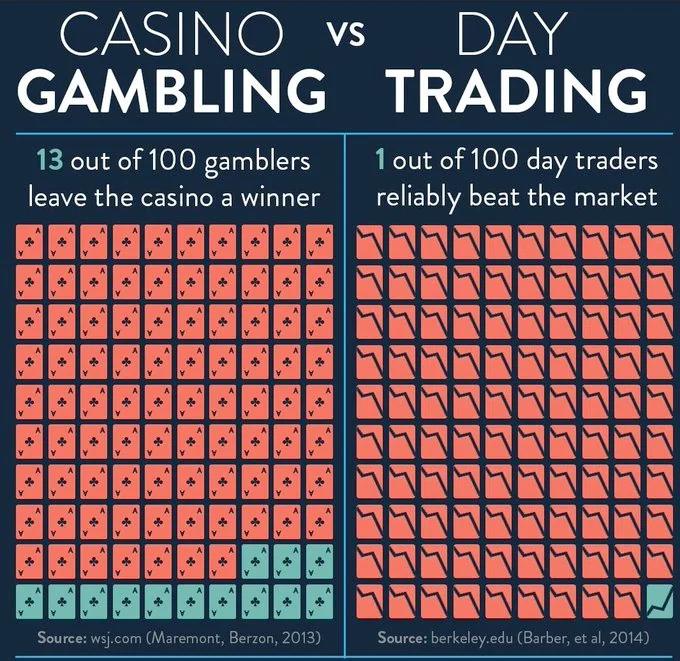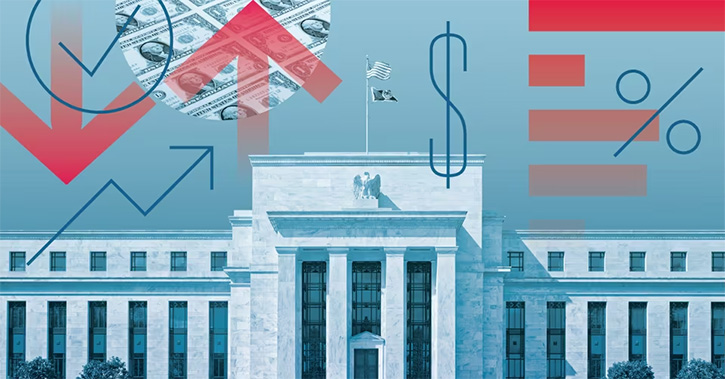
You may have seen the chart below. It has appeared on Reddit threads, X posts, and other locations. It purports to show that casino gamblers have a better chance of turning a profit than do stock market day traders.

Don’t believe your eyes. The illustration is social-media blarney.
Frankenstein's Monster
The source of the graphic remains a mystery to me. Although each link above dates from the past 12 months, the underlying work was published long ago. The results for the casino gamblers come from an October 2013 article in The Wall Street Journal, while the initial research on the day traders started in 2004. (This link is to a newer version of that paper, also published in 2013.)
It appears that the chart was created last year, when somebody combined those two findings. Doing so created a problem, because the research was conducted by different parties, neither of whom realized the other existed. The graphic’s wording reveals the inconsistency: “13 out of 100 gamblers leave the casino a winner,” while “1 out of 100 day traders reliably beat the market.” The statements are dissimilar. As were the parts for Frankenstein's monster.
From the Rekenthaler archives: When investing crosses the line into gambling.
Gambling vs. Day Trading: Misaligned Standards
Let's start with the gamblers. That 13% citation is slightly off. That number comes not from published research, but instead from a background check requested by the Journal story's authors. The article's official figure for casino-gambling results is 11%, taken from a Harvard Medical School study on internet wagers.
Eleven percent rather than 13. Close enough, I suppose. The main point is that these outcomes are simple percentages. They represent the number of gamblers who earned profits over that two-year stretch divided by the total participants. (That time period sounds substantial, but as bettors who wagered as infrequently as four days over those 2 years qualified for the study, the subjects were not necessarily gambling regulars.)
In contrast, the published totals for day traders are statistically significant estimates. This is an entirely different approach! Write the authors, “In the average year, about 450,000 individuals engage in day trading. While about 20% earn profits net of fees in the typical year, the results of our analysis suggest that less than 1% of day traders are able to outperform consistently.” [The italics are mine.] To restate that sentence, on average, the authors discard 19 out of 20 observations of profitable day traders because they can't prove that their investment gains came from luck rather than skill.
Game over. When calculated by the same approach of simple percentages, the success rates of casino/sports gamblers versus day traders were not 13% to 1% but instead 13% to 20%. Per the evidence, the day traders were the likelier winners!
Research From Another Country, Another Era
But … things get worse.
The day-trading research is based not on the United States stock market, but instead on Taiwan's. And not current conditions in Taiwan, either. The authors' data was compiled from 1992 through 2006.
Setting aside the question of whether the trading skills of the previous generation's Taiwanese speculators match those of their modern American counterparts—I wouldn't be surprised if they did, but one can only guess—the conditions of those two marketplaces are very different. Trading in Taiwan during the '90s was much costlier than doing so in the United States today.
The Price Wasn't Right
Let us count the ways, starting small. At the time, Taiwanese brokers charged commissions on all stock trades, as did brokerage firms throughout the world. For preferred customers, the fee was modest, being 5 basis points (0.05%) of the transaction price. Since gains and losses for day trades are computed on round trips, the total commission paid for such trades was 10 basis points. (Note: The authors included trades that stayed open as long as 5 days in their calculations, so technically the paper measured “up to 5 days” trades.)
Transaction taxes levied an additional, higher expense. Although Taiwan did not tax stock purchases, the nation charged 30 basis points on equity sales. That increases the round-trip cost to 40 basis points.
The authors incorporated that 40 basis-point expense into their calculations. However, they did not address trading spreads—that is, the gap between a stock's bid and ask prices—because such costs are implicit, being built into share prices. Fortunately for my purpose, which is to contrast the transaction costs of the equity markets of 1990s Taiwan and 2024 United States, the authors did measure the average spread during that period: 64 basis points.
On average, therefore, each day trade cost the study's Taiwanese subjects 104 basis points. Ten points for commissions, 30 in taxes, and 64 to cover the spread.
In contrast, day traders in the US currently pay no commissions, no transaction tax, and much smaller spreads on major stocks. As I write this column, the bid price on Nvidia (NVDA) is $119.02, while the ask price is $119.08. The respective prices for Tesla (TSLA) are $220.14 and $220.23, while those for Amazon.com (AMZN) are $186.31 and $186.65. That makes for spreads of 5, 4, and 18 basis points, respectively. Let's be conservative and call the large-company average 15 basis points. That makes for the following comparison.
If 20% of Taiwanese day traders finished each year in the black while forfeiting 104 basis points of their potential gains, then presumably today's US speculators are faring better, as their house extracts only 1/7th of that amount. Of course, that is merely a hypothesis; it could be that, despite greatly improved odds, they aren't as successful as last generation's Taiwan day traders. But that possibility would not, as the saying goes, be the right way to bet.
Why I Dislike Day Trading
As you might expect from somebody slated to speak at this year's Bogleheads Conference, I dislike day trading. It is speculation at best and gambling at worst. Also, it misses the point of equity investing, which is to participate in the extraordinary earnings growth that businesses in developed markets have enjoyed over the past eight decades. (Many emerging-markets companies have performed even better, but their results have been much less consistent.)
However, there are better ways of serving a truth than by propagating a lie.
John Rekenthaler is vice president for research at Morningstar. This article originally appeared on our U.S. homepage




















